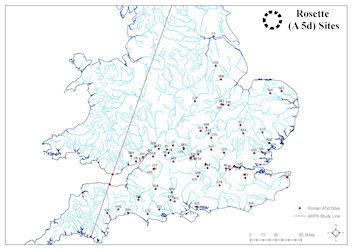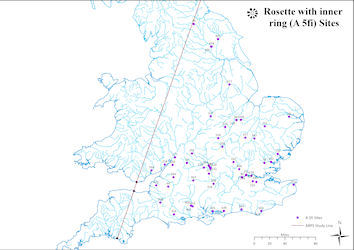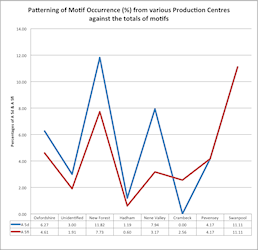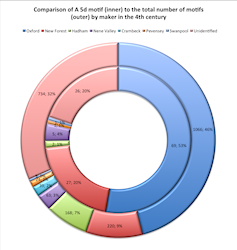

The situation in the late Roman period could not be more different. There are only seven examples of the A 5d motif north of a line from the Wash to the Severn Estuary out of 125 examples identified by March 2015. These are one each from Brough-on-Humber, Caerwent, Leicester (Jewry Wall), Lincoln (Flaxengate), Old Sleaford, and two from the fort at Usk (Figure 4). Equally, I have recorded 87 examples of the A 5fi motif by March 2015, but only eight come from north of the same line: one each from Caerleon, the Catterick bypass, the Crambeck kilns, Leicester (Jewry Wall), Lincoln (Hungate), the temple at Lydney Park (Gloucs), and in York from the Bishophill site in the colonia and The Mount cemetery (Figure 5).

Both motifs represent a large segment of the total examples recorded for the 4th century (Table 1): only the basic rosette motifs (A 5a) and the demi-rosettes (G 2a) have more examples recorded. Percentage-wise the motif occurrence shows some distinct patterns (Figure 6).

| Production centre | Total stamps attributed | No. of A 5d | No. of A 5fi |
|---|---|---|---|
| Oxfordshire [OXRS] | 1,085 | 68 | 50 |
| Unidentified | 732 | 22 | 14 |
| New Forest [NFCC] | 221 | 26 | 17 |
| Hadham [HARS] | 169 | 2 | 1 |
| Nene Valley [NVCC] | 63 | 5 | 2 |
| Crambeck [CRAM] | 39 | 0 | 1 |
| Pevensey [PVRS] | 24 | 1 | 1 |
| Swanpool | 9 | 1 | 1 |
| Totals | 2,342 | 125 | 87 |
Looking at the distribution maps for the two motifs during the 4th century, it is striking how different they are. Out of the 116 sites shown on the two maps, there are only 19 sites where both motifs have been found (Figure 7 and Table 2).

| Site no. | Parish | Site | County |
|---|---|---|---|
| 400 | Armsley | Well | Hants |
| 401 | Ashley Rails | Kilns | Hants |
| 19 | Barnsley Park | Villa | Glos |
| 134 | Berinsfield | Wally Corner | Oxon |
| 60 | Caistor St Edmund | Town | Norfolk |
| 110 | Colchester | Balkerne Lane | Essex |
| 192 | Heybridge | Elizabeth Way | Essex |
| 208 | Ilchester | Kingshams | Somerset |
| 227 | Leicester | Jewry Wall | Leics |
| 507 | London | Site in City | London, Greater |
| 579 | London SE18 | Woolwich Power Station | London, Greater |
| 80 | London SW6 | Fulham Palace Moat | London, Greater |
| 16 | Marsh Baldon | Golden Balls Crossroads | Oxon |
| 266 | Marshfield | Ironmongers Piece Villa | Avon |
| 303 | Pevensey | Castle (Outer Court) | Sussex, E |
| 305 | Portchester | Castle | Hants |
| 311 | Richborough | Fort | Kent |
| 326 | Silchester | Town | Hants |
| 336 | Stanground | Park Farm | Cambs |
There are also five towns or cities where both motifs have been found, but on separate sites. These are Chelmsford, Gloucester, Lincoln and Milton Keynes (Table 3), plus various sites in the City of London and Southwark.
| Code | Parish | Site | County |
|---|---|---|---|
| 78 | Chelmsford | Sites S & K | Essex |
| 171 | Gloucester | Bon Marché New Market Hall | Gloucs |
| 617 | Lincoln | Flaxengate Hungate | Lincs |
| 270 | Milton Keynes | Caldecotte (Lake) | Bucks |
| 269 | Milton Keynes | Bancroft Villa | Bucks |
The Oxfordshire production centre was by far the most prolific in its stamped wares output, producing respectively 54.4 per cent of the A 5d motifs and 58.5 per cent of the A 5fi motifs. However, it is clear from the distribution maps that the kilns producing wares that employed the A 5d and A 5fi motifs were not in Oxford itself, but came almost exclusively from Young's Southern Group 3 kilns (nos 28-31) (Young 1977, 5 and 12-13). Young comments of this sub-group:
'The towns of Alchester and Dorchester[-on-Thames] and the villas that they served must have provided a market for fine Romanised wares from an early stage in the Roman occupation. The Group 3 kilns were in an exceptionally good position to meet this need. They were located close to their initial markets and they had excellent communications.' (Young 1977, 13)
Stuart Laycock suggests Dorchester-on-Thames may have been a potential flashpoint on a disputed boundary between the Catuvellauni and Dobunni people (Laycock 2008, 174). He also suggests that the very early Anglo-Saxon settlements in the vicinity may represent a foederati command who had been recruited by the Catuvellauni to defend the important Thames crossing and who had decided to stay and put down roots. It would be going too far to suggest that the fashion for stamped pottery was driven by their arrival as Young dates the rise of its popularity to around AD 340 (Young 1977, 132), but they may well have provided a larger clientele for such decorative wares than would otherwise have been the case.
The New Forest kilns, by contrast, manufactured much less stamped pottery overall. They produced respectively just 20.8 per cent of the A 5d motifs and 19.5 per cent of the A 5fi motifs. Apart from a couple of outliers (at Caistor St Edmund/by Norwich, Norfolk, and Leicester, Jewry Wall), all examples of the A 5d motif on New Forest Ware come from south of a line from the Severn Estuary to the Thames mouth. The same is true of the A 5fi motifs, apart from one outlier at Leicester, Jewry Wall. The distribution maps show an interesting run of sites along the south coast, comprising Portchester, Pevensey and Richborough, which may demonstrate a coastal trade emanating from the New Forest kilns - both motifs have been found at Ashley Rails. Current thinking is that the Pevensey Ware factory, wherever it was located, was founded by a potter who had trained in the Oxford area (Jane Timby, pers. comm.), but he (or she) must have been aware of what was going on in the New Forest area because both stamped and unstamped New Forest Wares have been found at Pevensey (Salzmann 1909, 92; Lyne 2009, 109-10).

Twenty per cent of the A 5d and seventeen per cent of the A 5fi motifs from the 4th century have not been attributed to a production centre, which obviously partially skews any attempts at analysis (Figs 8 and 9). Three of the anonymous A 5fi examples come from York and Catterick, both in North Yorkshire, and I am of the opinion that they may possibly have been manufactured in the so-called Parisian area - in southern Yorkshire or northern Lincolnshire. In York, the die used to make the stamp from Bishophill (Roberts 1982, fig. 39-D24.8) is not dissimilar to Elsdon's no. 67 from Dragonby (Elsdon 1982, fig. 7). The example from The Mount cemetery, York (Roberts 1982, fig. 49-X24.5), is similar to a Parisian example from Brough (Corder 1956, fig. 2-3). The example from Catterick does not have any obvious parallels (Wilson 2002, Vol. 2, fig. 182-B10.3). One of the anonymous A 5d stamps comes from Brough-on-Humber and appears to be similar to examples shown by Elsdon from Dragonby (fig. 10-69b) and Old Winteringham (fig. 10-72).

Statistical analysis (Nearest Neighbour Index and Ripley's K, see O'Sullivan and Unwin 2003, ch. 4, 77-114) of the A 5d motif demonstrates some clustering, particularly along the Bristol-London axis.